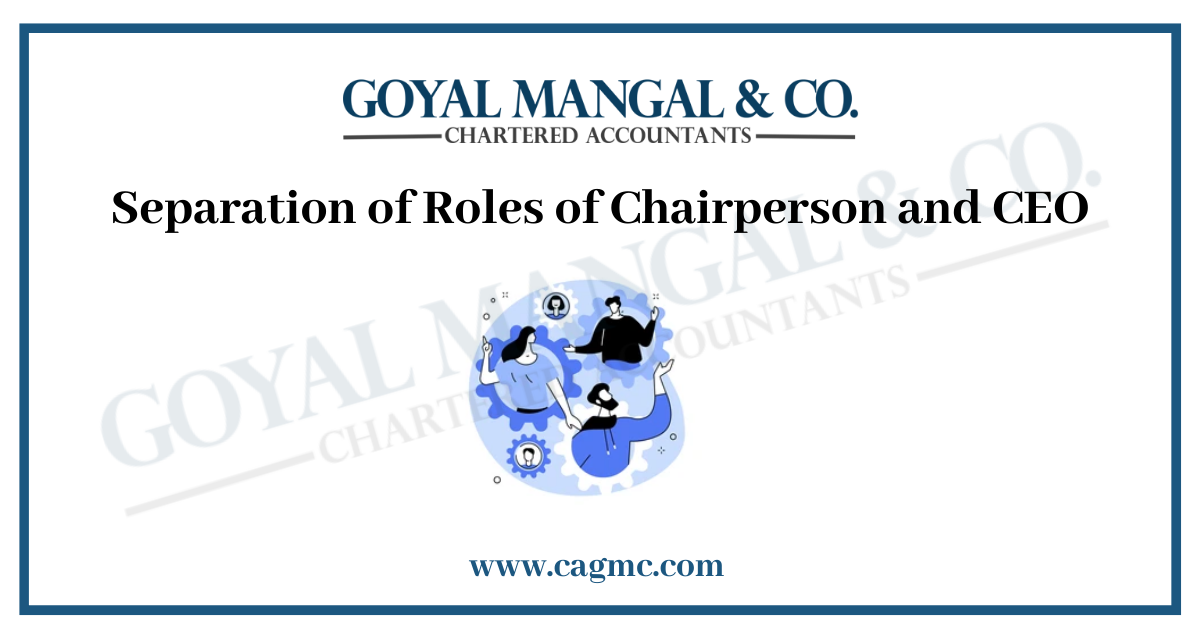
SEBI (Securities and Exchange Board of India), decided during a board meeting held on 15 February 2022 to make it voluntary for the top 500 listed companies to separate the role of the chairperson of the Board and the chief executive officer (CEO) of the company. Before dealing with the Separation of Roles of Chairperson and CEO, let us about the roles of chairperson/chairman and CEO.
| Table of Content |
Chairperson and CEO of a company
The chairman is the head of the board of directors or the head of the company. Usually, shareholders elect the company’s chairperson.
The chief executive officer (CEO) is the topmost position in an entity. They are responsible for executing the existing plans and policies of the company. CEO ensures the positive management of the business and sets future strategies. Further, the CEO is ultimately responsible for the success or failure of the company.
Role of a Chairperson
The chairman is the head of the board of directors or the head of the company. Usually, the shareholders elect the company’s chairperson. Further, their responsibilities may mainly comprise protecting the investor’s interests.
The following are some of the roles of the chairperson:
- Founding agendas for board meetings as per the company’s objectives
- Signifying the investor’s interest in board meetings and debates
- Appointing and terminating senior executives
- Evaluating the performance of high-level managers and making references for enhancements
- Continuing the firmness of the company and safeguarding its existence during periods of economic change or instability
- Revising financial results and establishing internal control systems to guarantee their correctness and transparency, and many more.
Role of a CEO
A company has multiple directors and they all have to report to the CEO of the company. A CEO mostly work for the company’s primary decision-making.
The following are some of the roles of a chief executive officer (CEO):
- Establish a tone for the company’s culture and communicate the company’s aim
- Guiding the company’s growth
- Making top-level strategic decisions
- Building and refining relationships with other companies
- Managing resources and collaborating with the finance team for tracking the expenses and revenue
- Managing market placement, exploring expansion opportunities, etc. to surge the company’s success
- Working as a board member with an outlook on day-to-day operations
- Implementing board decisions, etc.
Who has more power, the CEO or the Chairperson?
Theoretically, a chairman has more authority than a CEO. But, the CEO is the company’s chief leader and reports to the board of directors, which is chaired by the chairman. A CEO has responsibility for carrying out the board’s approved plans. Further, they are the ones who are most noticeable in action.
Separation of Role of Chairperson and CEO
SEBI (LODR) Regulations, 2015 and SEBI (LODR) Amendment Regulations, 2018
In 2018, the SEBI amended the SEBI (Listing Obligations and Disclosure Requirements) Regulations, 2015 commanding the top 500 listed companies to guarantee that the chairperson shall
- be a non-executive director and
- not be related to the Managing Director or the CEO, as per the definition of ‘relative’ under Section 2(77) of the Companies Act, 2013.
Deadline for Compliance
The deadline for compliance was extended by 2 years. The new rule was sought to be enforced from 1 April 2020, but based on business representations, the deadline was prolonged to 1 April 2022.
SEBI’s proposal to divide the roles of the chairperson and CEO was based on the 2017 report of the Committee on Corporate Governance (Kotak Committee), which, citing the Cadbury Committee report (1992), suggested the separation for reasons like;
- to provide a structural advantage for the board to act independently and
- to reduce the excessive concentration of power in a sole individual.
In the current scenario, the capability of the board to observe management has become keen important. Consequently, if the chairperson (as the board’s leader) is the same person as the CEO (the leader of the management), conflicts of interest may arise.
Section 203 of the Companies Act, 2013 says that the same person cannot hold the position of chairperson and CEO at the same time. On the other hand, section 203 is a default provision which can be deviated from, if the company’s articles of association permit.
Compliance with these provisions made voluntarily – SEBI Board Meeting (February 2022)
SEBI had faced a low level of compliance from September 2019 until December 2021, the percentage of compliant companies only moved from 50.4% to 54.0%. Few arguments say that Indian company law already encloses sufficient requirements to check conflicts of interest, counting those about a minimum number of independent directors and precluding voting by interested parties on related party transactions. So, the focus must be on strengthening the ‘independence’ of independent directors, instead of tackling the chairperson-CEO split, which is relatively trouble-free in India.
As per section 203 of the companies Act 2013, it’s the fundamental spirit of shareholders’ democracy to make decisions to split the roles of chairperson and CEO or not. The shareholders of each company should be allowed to decide whether they prefer the roles of chairperson and CEO to be entrusted to the same person or two different persons.
If any company makes a default in complying with provisions of section 203, the company shall be liable for a penalty of Rs. 5 lakhs. Further, in case of director or KMP is in default then they will be liable to a penalty of Rs. 50,000.
Considering a rather unsatisfactory level of compliance achieved so far by SEBI, concerning this:
- corporate governance reform,
- various representations received,
- constraints posed by the prevailing pandemic situation and
- a view to enabling the companies to plan for a smoother transition,
As a way forward, SEBI Board at this juncture decided that this provision may not be retained as a mandatory requirement and instead be made applicable to the listed entities on a “voluntary basis”.
Conclusion
Therefore, SEBI has removed the mandatory separation and decided to make it voluntary for the companies to separate the roles of the chairperson and CEO of the company. So, it’s up to the company to make a decision on the separation of roles.


